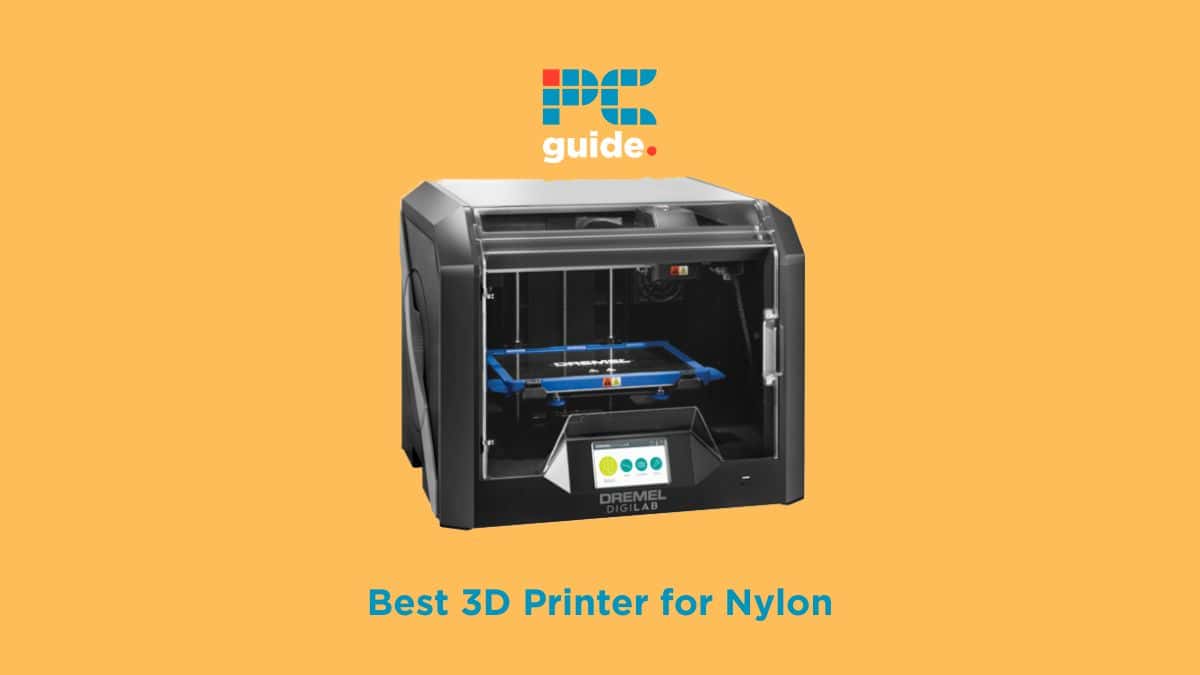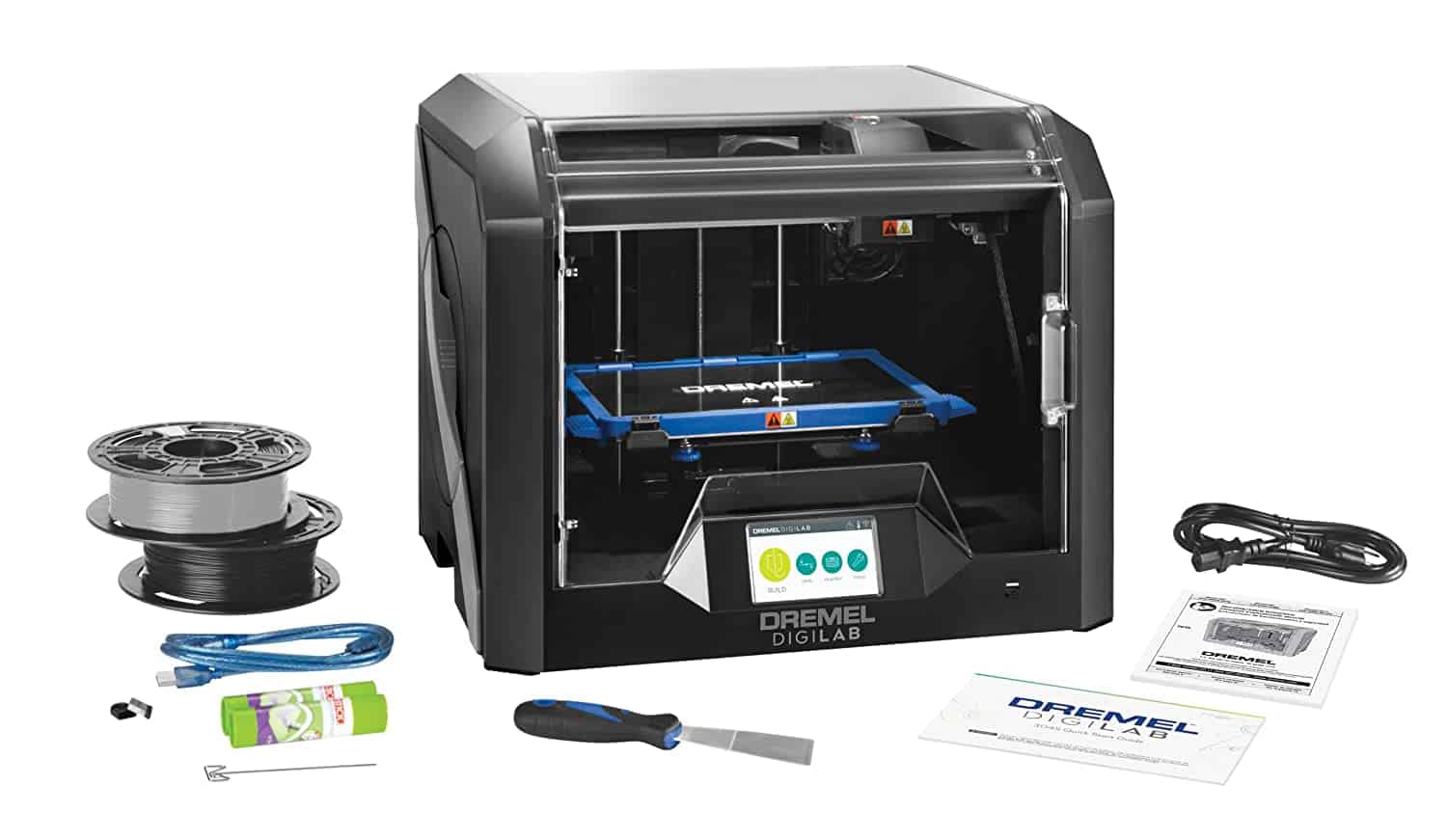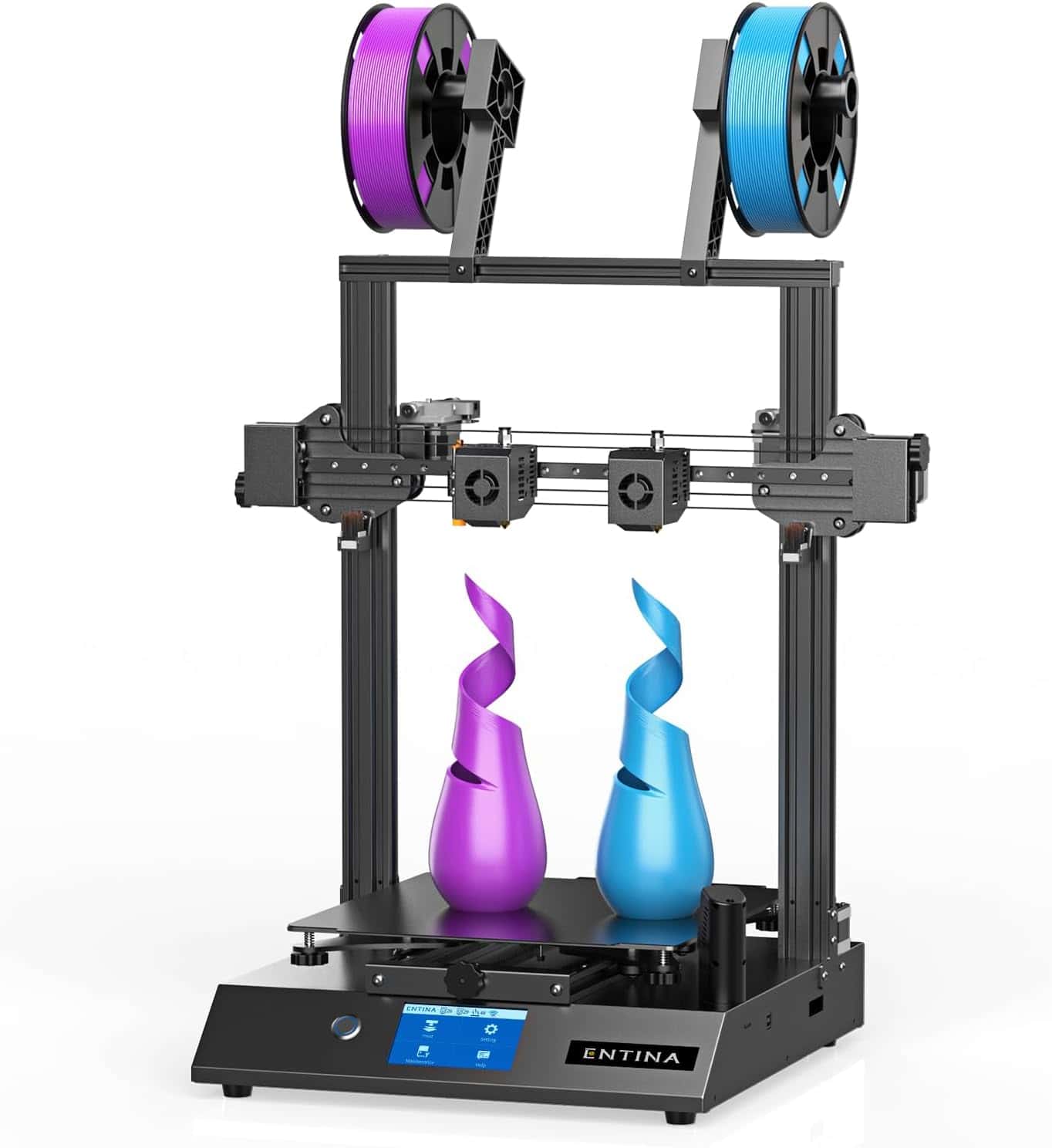Best 3D Printer for Nylon in 2025: How to 3D Print with Nylon

Table of Contents
If you're keen on finding the best 3D printer for nylon, you aren't alone. Nylon has become a fast favorite for 3D printing: striking a perfect balance between durability, flexibility, and resistance to abrasions. However, unlike other common materials such as PLA and ABS, not all 3D printers work with nylon – which can make your shopping experience challenging.
Fortunately, we've compiled a list of the best 3D printers for nylon already! We've reviewed an array of models across different printing needs, so you'll find a suitable product for you no matter what!
-
Best 3D Printer for Nylon
Dremel DigiLab 3D45 3D Printer
- Build Volume: 254mm x 152mm x 170 mm
- Filament: PLA, ABS, PETG, Nylon,
- Connectivity Technology: USB
- Filetype: GCode
-
Best Efficient 3D Printer for Nylon
Creality K1 Max
- Build Volume: 300mm x 300mm x 300mm
- Filament: PLA, ABS, PETG, PET, TPU, Nylon
- Connectivity Technology : USB, Ethernet, WiFi
- Filetype: STL, OBJ, AMF
-
Best IDEX 3D Printer for Nylon
Entina X40 V3
- Build Volume: 300mm x 300mm x 400mm
- Filament: PLA, ABS, PETG, Metal, Nylon, Wood
- Connectivity Technology: USB, WiFi, TF Card
- Filetype: STL, OBJ, G-code
-
Best Purpose-Built 3D Printer for Nylon
QIDI Technology X-CF Pro
- Build Volume: 300mm x 250mm x 300mm
- Filament: PLA, ABS, PETG, Nylon, Carbon Fiber
- Connectivity Technology: USB, WiFI
- Filetype: STL
-
Best Large-Volume 3D Printer for Nylon
Creality CR-M4
- Build Volume: 450mm x 450mm x 470mm
- Filament: PLA, ABS, PETG, TPU, Nylon
- Connectivity Technology: USB, USB-C, WiFi Direct
- Filetype: STL, OBJ, AMF
How We Picked the Best 3D Printer for Nylon
To satisfy as many 3D printing needs as possible, we diversified our choices to include different prices, speeds, and resolutions. We also prioritized versatile filament compatibility to ensure that the printers are efficient in printing more than just nylon. For beginners in the field, we also considered any user-friendly features. 3D printing is difficult at the best of times, so we like to see printers that do their best to make it easier. Features such as touchscreens, easy-to-use slicers or multiple connectivity options are highly appreciated.

- Build Volume: 254mm x 152mm x 170 mm
- Filament: PLA, ABS, PETG, Nylon,
- Connectivity Technology: USB
- Filetype: GCode
Not just the best 3D printer for Nylon, the 3D45 is one of our favorite printers on the market, period.
- High print quality – accurate to within 0.05mm, the DigiLab is well-suited to complex prints.
- Varied filament compatibility – with a range of compatible filaments from PLA to Nylon, you've got plenty of print options to choose from.
- Limited build volume – the enclosed design of the DigiLab means that its volume is fundamentally limited.
With excellent productivity, an intuitive interface, and advanced printing technologies, the award-winning Dremel DigiLab 3D45 stands proudly as the best nylon printer on the market. It prints nylon with unmatched intricacy and packs a ton of great features that make it an easy cinch for the best 3D printer for nylon.
The printer's standout feature is its automated 9-point leveling, which is capable of detecting and accounting for any change in the print bed without interference from you. Other than nylon, the 3D45 can print using ABS, PLA, and PETG. On top of that, it boasts a filament run-out detection feature that pauses the printing process if the filament runs out and continues normally after it's loaded again. To top it all off, the 3D45 features a 4.5-inch touchscreen that you can use to navigate its options and a built-in HD camera where you can watch the printing process step by step.
We do have a nitpick with this 3D printer, however. Due to the closed-frame design, the 3D45's maximum build volume is limited – despite the unit itself being bulkier than many of its contemporaries. It's an ironically small issue, however, and we still highly recommend this amazing 3D printer for nylon.

- Build Volume: 300mm x 300mm x 300mm
- Filament: PLA, ABS, PETG, PET, TPU, Nylon
- Connectivity Technology : USB, Ethernet, WiFi
- Filetype: STL, OBJ, AMF
For fast printing speeds, even with Nylon, the K1 Max is near-unbeatable for efficiency, and one of our favorite Creality 3D printers.
- Fast printing – at 600mm/s, the K1 Max is a productivity powerhouse.
- Large build volume – the 300mm x 300mm x 300mm build volume makes for plenty of room to print.
- Loud – even the enclosed design of the K1 Max can’t cancel out the noise.
We discussed the K1 Max in our list of the best multi-color 3D printers, and its versatility is just one of the many reasons we love this 3D printer. There's a lot of reasons to love this hyper-efficient product from one of our favorite manufacturers, and not just because it prints nylon!
The K1 Max redefines efficiency in the world of 3D printing with its 600mm/s speed, 20,000mm/s² acceleration, and 32mm³/s full-blast feeding flow. It's 12% faster than average FDM printers, making it one of the most efficient and productive models on the market. Designed with beginners in mind, the K1 Max comes assembled and ready to use out of the box. It also comes with pre-defined calibrations and automatic leveling to make your life easier. For printing specialty filaments, the printer features a hot end surrounded by a ceramic heater. As a bonus, if you plan on sharing your process, an AI camera allows you to track your print progress in real-time.
It's not all good news, however. We've mentioned before how the single extruder is a bit of a design oversight for more complex builds, and the printer itself is very noisy, especially by closed-frame standards. A supposed benefit of closed-frame printing is the reduced noise, but the K1 Max seems hell-bent on proving that wrong. But if you desire high efficiency and don't mind the noise, we highly recommend the K1 Max as a 3D printer for nylon!

- Build Volume: 300mm x 300mm x 400mm
- Filament: PLA, ABS, PETG, Metal, Nylon, Wood
- Connectivity Technology: USB, WiFi, TF Card
- Filetype: STL, OBJ, G-code
Boasting powerful dual extruder technology, the X40 V3 is another one of our favorite 3D printers.
- Median price – it’s rare to find an IDEX 3D printer under $1000, but the X40 V3 manages just that.
- Versatile print options – with IDEX technology and a wide range of compatible filament, the X40 V3 is a highly useful 3D printer.
- Open-frame design – the fumes emitted when extruding nylon are in the open air with this open-frame printer.
For simultaneous 3D printing with nylon, the Entina X40 V3 comes with Independent Dual Extruders that give you some extra dynamism when creating models. Entina printers are plucky models that often go underappreciated, but make no mistake: this printer is far from an underdog.
Designed with versatile printing needs in mind, the Entina X40 V3 offers four modes of printing: dual material printing, single material printing, duplication, and mirror mode. This is thanks to the versatile IDEX system that is sure to speed up your smaller-scale prints – enabling more varied models and even the possibility to print two models at once. For ease of use, the printer features automatic leveling and supports Wi-Fi printing. Thanks to its smart connectivity option, you get to enjoy a massive model library and compatibility with various slicing software. As a bonus, it's equipped with a built-in camera that connects through Wi-Fi, and you can use it to watch the printing process up close.
The one design oversight we noted was that there is no automated leveling for dual printing: meaning that you'll have to manually adjust the beds for both models. It adds a frustrating manual element to an otherwise hands-free 3D printing experience, and the IDEX system works a treat for printing with nylon!

- Build Volume: 300mm x 250mm x 300mm
- Filament: PLA, ABS, PETG, Nylon, Carbon Fiber
- Connectivity Technology: USB, WiFI
- Filetype: STL
Tailored to nylon filament, the X-CF Pro is a great blend of versatile and specialized 3D printing.
- Highly accurate – with print resolution as precise as 50 microns, details are rendered carefully in the X-CF Pro.
- Built-in camera – observe your print-in-progress with the X-CF Pro's built-in camera.
- Premium pricing – the cost of the X-CF Pro may deter some hobbyists.
If you require a premium print experience designed explicitly with nylon in mind, QIDI Technology's X-CF Pro model of 3D printer is the ultimate choice. If you can swallow the price tag, you'll be glad you paid for such a high-quality and versatile printer.
For a smooth printing experience, the X-CF Pro features an intelligent leveling mode that optimizes the bed position with the nozzle. Combined with its dual Z-axis, both features guarantee you high-precision printing with accurate parameters. We always appreciate a filament run-out detector, so it is gratifying to see it as standard here. With a build volume of around 10 inches in every direction (11.8″x 11.8″x 9.8″), you should be able to print high-quality and high-speed models from Carbon Fiber, ABS, TPU, PVA, PLA, and – of course – nylon.
You'll need to use the X-CF Pro frequently to get your money's worth from it, however, as it is far from a cheap model. And weighing north of 80 pounds, you can't take it with you! But for a tailored nylon printing experience with a gamut of great features, QIDI Technology has the best 3D printer for you!

- Build Volume: 450mm x 450mm x 470mm
- Filament: PLA, ABS, PETG, TPU, Nylon
- Connectivity Technology: USB, USB-C, WiFi Direct
- Filetype: STL, OBJ, AMF
Boasting a huge build volume in its open-frame design, the CR-M4 is a criminally underrated Creality printer.
- Large build volume – the CR-M4 can accommodate all your print needs thanks to its 450mm x 450mm x 470mm build volume.
- Powerful extruder – featuring a dual-gear extruder and vibration compensation, prints are detailed and have little-to-no warping.
- Difficult design – maintaining the CR-M4 can be a hassle due to the number of specialist parts required.
Finally, if you need to print large 3D models in nylon, then the CR-M4 from Creality is an ideal choice. With the largest build volume of any on our list, and some great features alongside that, you'd be hard-pressed to find a better large-volume printer than this!
The CR-M4 features an all-metal direct dual-gear extruder that ensures 3D printing with high precision. It also provides excellent stability because of the two support bars that surround the Z-axis. Thanks to these features, you're guaranteed seamless models with no resonance lines. But of course, the selling point of this model is its build volume: topping out at a mighty 17.71″x 17.71″x 18.5″, this is ideal for larger-scale 3D printing.
So why isn't this the best 3D printer for nylon overall? There are two primary tradeoffs with the CR-M4 that caused us to lower our ranking: like the QIDI X-CF, it is a bulky and hefty model – and thanks to it using different extruders and parts to nearly every other Creality model, maintaining or servicing the CR-M4 can be a hassle. Other than that, we still highly recommend the CR-M4 for large format 3D printing with nylon!
Features and Considerations
When looking into choices for the best 3D printer for nylon, there are some key points to consider:
Filament Compatibility
As mentioned, finding a 3D printer for nylon can be challenging. Nylon filament (sometimes called PA) requires high temperatures to become moldable, so all-metal components are needed to reach the requisite temperatures. Most printers list all their compatible materials but make sure that your choice can take the heat.
Connectivity Options
3D printers either come with one or multiple connectivity options. The most common option you'll come across is USB, which is convenient for laptops and PCs. However, it isn't suitable for printing from a tablet or a smartphone. If you want more freedom in choosing the device you're printing from, you should look for a 3D printer with Wi-Fi connectivity. Another useful option is SD memory compatibility, for compact transport of large files.
Build Volume
As you've seen above, each printer comes with a unique build volume. Naturally, open-frame printers come with larger volumes because they have more space for printing, while closed-frame printers have limited areas. Since each industry has its needs, you should choose a build volume depending on your work nature.
FAQs
Does 3D printing nylon release fumes?
Yes. Nylon emits toxic fumes when subjected to high temperatures, which happens during 3D printing. Accordingly, you should print it in a closed-frame printer for more safety. If you need to use an open-frame printer, make sure to put it in an adequately ventilated room and limit your exposure to the fumes.
Can I 3D print with nylon?
Depending on your 3D printer, it is possible to print nylon – but it requires high temperatures. Most FDM printers can't create the adequate heat for 3D printing nylon.

- Build Volume: 254mm x 152mm x 170 mm
- Filament: PLA, ABS, PETG, Nylon,
- Connectivity Technology: USB
- Filetype: GCode
Combining the strengths of great 3D printers with none of the weaknesses, the DigiLab 3D45 from Dremel is our top pick for the best 3D printer for nylon! Though it doesn't have the largest print volume, it has many other beneficial features and matches the needs of veteran or entry-level model-makers looking to print with nylon!
If you're looking to 3D print on a much larger scale, we have a great guide on some of the best industrial 3D printers on the market – check it out!